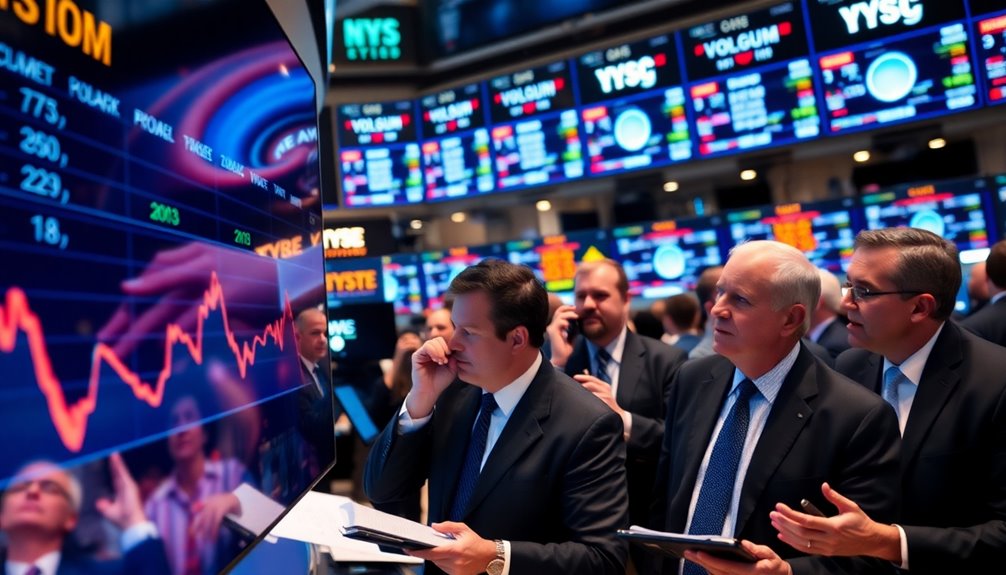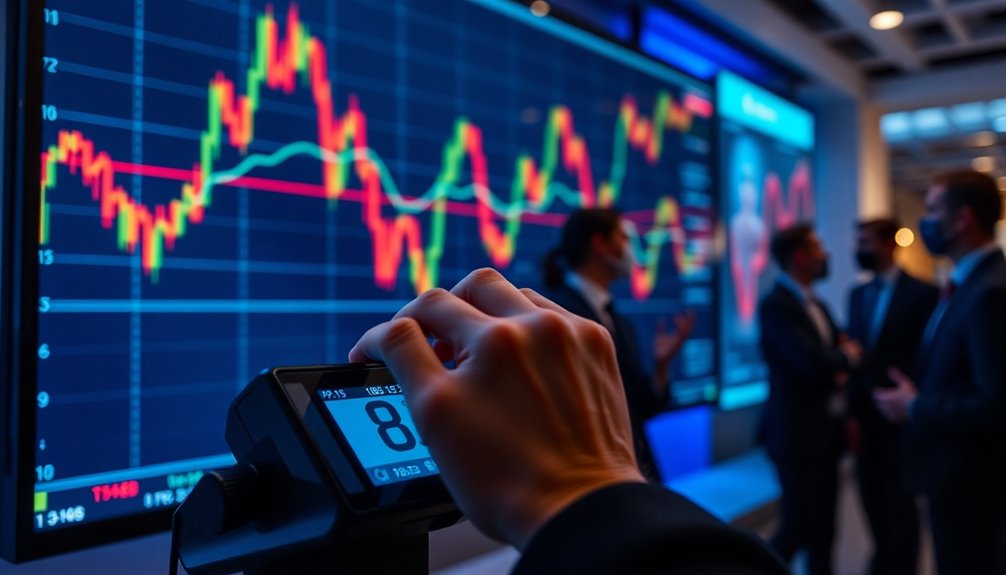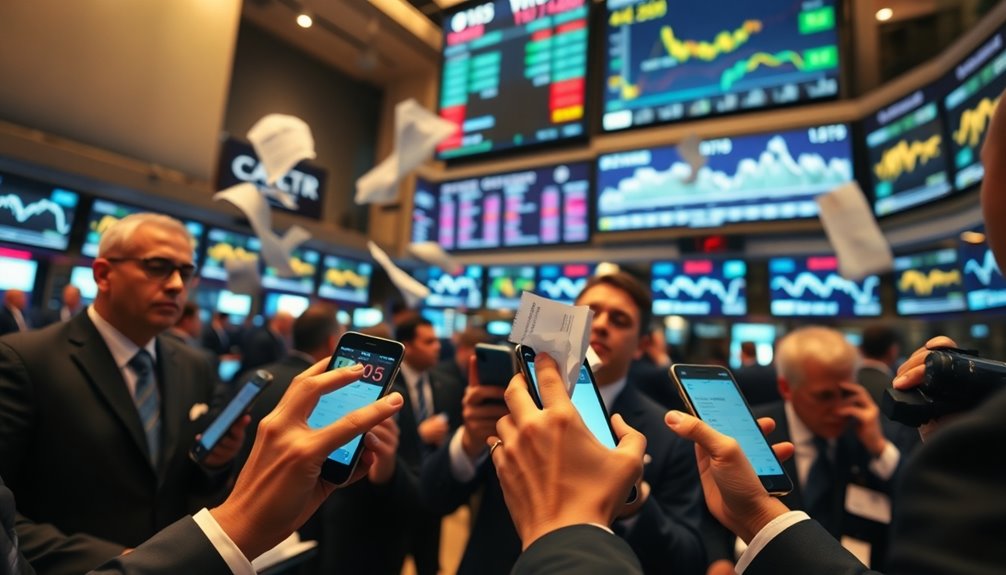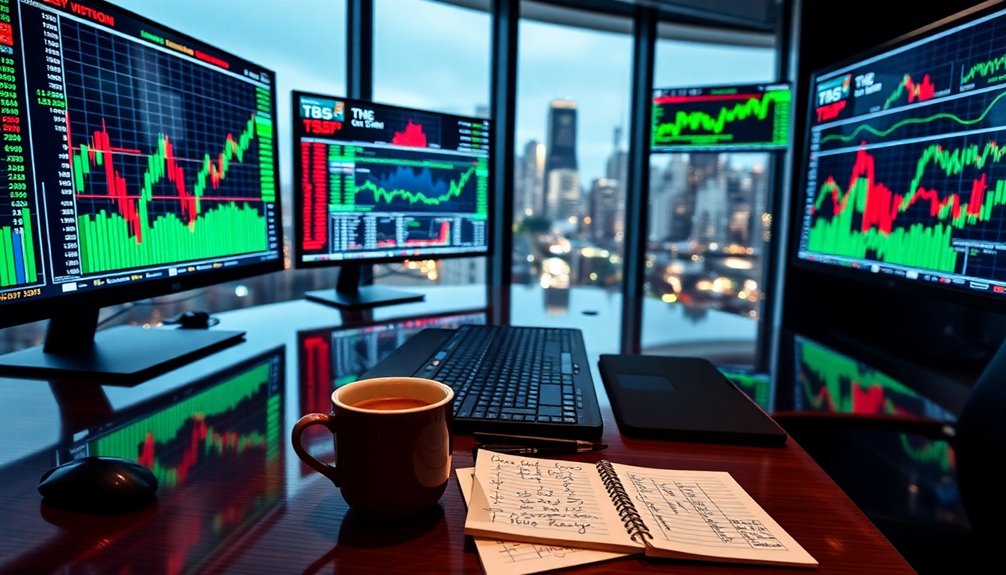Trade volume is the total number of shares or contracts traded for a specific security within a set timeframe. It offers crucial insights into market activity and liquidity. Higher volumes generally indicate better liquidity, meaning you can buy or sell more easily. When you analyze trade volume alongside price movements, it helps confirm trends and signals market sentiment. A sudden spike in volume might suggest significant market events or shifts in investor interest. If you want to uncover the deeper impacts of trade volume on investment strategies, you'll find more valuable information just ahead.
Key Takeaways
- Trade volume measures the total number of shares or contracts traded within a specific timeframe, reflecting market activity and liquidity.
- Higher trade volumes indicate better market liquidity, allowing for quicker transactions and potential price movements.
- On-Balance Volume (OBV) and average volume help analyze buying versus selling pressure, confirming price trends.
- Elevated trade volume during price increases suggests strong buyer interest, while high volume declines indicate strong selling pressure.
- Trade volume metrics vary across securities, with larger companies typically exhibiting higher trading volumes due to increased investor interest.
Key Concepts of Trade Volume

Trade volume is a crucial metric in the financial markets, representing the total number of shares or contracts traded for a specific security or market within a set timeframe.
Understanding trade volume helps you gauge market liquidity; higher volumes often indicate better liquidity and can lead to more significant price movements.
You'll find that volume analysis is key for confirming price trends, especially when assessing buying pressure versus selling pressure.
By examining average trading volume, you can identify unusual spikes influenced by economic indicators or market events.
Additionally, technical analysis tools like On-Balance Volume (OBV) and the Accumulation/Distribution Line provide insights into the underlying dynamics of financial instruments, assisting you in making informed trading decisions.
Defining Trade Volume Metrics

Understanding trade volume metrics is essential for navigating the financial markets effectively. Trade volume measures the total number of shares traded over a specific time frame, often reported daily. This metric reflects market activity and liquidity, indicating how easily you can buy or sell a security.
Average volume helps you gauge typical trading patterns, while On-Balance Volume (OBV) and Relative Volume offer deeper insights into trends and investor interest. Market exchanges monitor these figures closely, providing end-of-day approximations that may be refined the following trading day.
Market Activity Measurement Method

When measuring market activity, you'll find that trade volume provides a clear snapshot of buying and selling activity for a particular security. This metric quantifies the total number of shares traded within a defined period, reported by market exchanges at various intervals.
Higher trade volumes often indicate increased liquidity, making it easier for investors to execute orders and potentially leading to price changes and greater volatility. Additionally, volume metrics can differ significantly across securities, with larger companies typically displaying higher trading volumes.
In technical analysis, traders use volume analysis to confirm price movements and interpret market sentiment by comparing current trade volume to historical averages, helping you make informed investment decisions.
Benefits and Drawbacks

While high trade volume can enhance market liquidity and facilitate quicker transactions, it also comes with its own set of drawbacks. Elevated trading volume often confirms the strength of price movements, helping you identify trends.
However, low volume can lead to higher volatility and wider bid-ask spreads, resulting in unfavorable execution prices when buying or selling. Relying solely on trade volume can be misleading; for instance, low volume during price increases might indicate weak momentum, leading to false signals and poor trading decisions.
Additionally, regulatory constraints, like those from Rule 144, can limit your ability to trade larger volumes, complicating your transactions without impacting market prices significantly.
Balancing these benefits and drawbacks is crucial for effective trading.
Volume Versus Price Correlation

Trade volume plays a crucial role in confirming price movements, allowing you to gauge the strength of market trends. High volume during a price increase suggests strong buyer interest, while low volume may indicate weak momentum.
When you see a price breakout through resistance levels with high volume, it's typically a strong signal of market participation, reinforcing the validity of the price change. Conversely, a price decline accompanied by high volume indicates strong selling pressure, whereas low volume drops suggest a lack of conviction among sellers.
Monitoring historical volume averages helps you assess current levels, as significant deviations can reveal unusual market activity. Ultimately, trade volume reflects market sentiment, with increasing volume during a bullish trend showing growing investor confidence.
Market Volatility Impacts Volume

Market volatility significantly affects trade volume, as traders often jump at the chance to exploit rapid price changes.
During periods of heightened uncertainty, like economic downturns or geopolitical events, you'll likely notice increased trade volume driven by heightened investor activity.
For instance, significant market events, such as earnings releases, can trigger trading volume spikes of over 200%. Increased market volatility can also widen bid-ask spreads, prompting you to execute more trades to manage your positions effectively.
In contrast, stable market conditions usually lead to decreased trade volume, as lower volatility results in less active trading.
Understanding how these dynamics work can help you navigate the complexities of trading during different market conditions.
Emerging Digital Trading Platforms

As digital trading platforms emerge, they've transformed how you measure and engage with trade volume, offering real-time data and analytics that empower you to make informed decisions.
These platforms leverage algorithmic trading and machine learning to analyze trade volume patterns, enhancing your ability to forecast market trends and volatility.
The rise of mobile trading apps has made it easier for you to participate in the markets, significantly increasing retail trading volume.
Moreover, social trading features allow you to observe and mimic experienced investors, influencing overall trade volume through collective behavior.
With blockchain technology, some platforms enable decentralized trading, altering traditional trade volume dynamics and improving liquidity in financial markets.
This evolution reshapes your trading experience fundamentally.
Monitor Market News Regularly

Staying updated with market news is essential for making informed trading decisions. By monitoring economic indicators, corporate earnings, and geopolitical events, you can better understand factors influencing trade volume.
Immediate news releases, like Federal Reserve announcements, often lead to spikes in trading volume as traders swiftly react to new information. Utilize social media platforms and financial news websites for real-time updates on market sentiment affecting trading activity.
Set up alerts and notifications from your trading platform to stay informed about significant market changes that could impact your trading strategies and volume analysis.
Additionally, being aware of seasonal trends and upcoming events allows you to anticipate potential increases in trade volume and adjust your strategies accordingly.
Frequently Asked Questions
What Does Trade Volume Mean?
Trade volume refers to the total number of shares or contracts traded during a specific time period.
It gives you insights into market activity and liquidity. When you see higher trade volumes, it usually means there's greater liquidity, which can help you execute orders better.
You'll notice that significant price movements paired with high volume often indicate reliable market trends, making it a key factor in your trading decisions.
Is Higher Trading Volume Good?
Oh sure, higher trading volume is just what you need to guarantee your fortune, right?
Well, it's often a good sign! When volume's up, it usually means more liquidity, which helps you execute orders better and narrow those pesky bid-ask spreads.
Just remember, though, if volume spikes during a price drop, it could mean trouble.
How Do You Calculate Trading Volume?
To calculate trading volume, you simply count the total number of shares or contracts traded within a specific period, like a day or week.
If you're looking at stocks, you'll sum the shares exchanged. For futures or options, you'll total the contracts traded.
Often, you can find this data reported by exchanges at the end of each trading day, which helps you understand the market's activity level over time.
How Much Is 1 Volume in Trading?
When you think about trading, "1 volume" simply means one unit of a security, like a single share of stock or one contract in derivatives.
It's crucial to understand this because it underpins how you measure market activity.
So, when you see a trade volume of 1,000, it means 1,000 units were traded.
This number helps you gauge liquidity and interest in a security, impacting your trading decisions significantly.
Conclusion
In summary, understanding trade volume is crucial for navigating the financial markets effectively. Did you know that in 2021, the average daily trading volume for U.S. stocks reached a staggering 10 billion shares? This figure highlights the dynamic nature of market activity and its impact on your trading strategies. By keeping an eye on trade volume, you can make more informed decisions, enhancing your ability to respond to market trends and fluctuations. Stay informed and adapt!









